My Zürich apartment building is a solid Swiss 1960s affair that has the odd twist of Japan (landscaping and terraces) and maybe a bit of Palm Springs (angular modernism and plenty of concrete). This August will mark five years of living under its gravel roof and on a sunny day like today, with the boats crisscrossing the lake, the meadows in the distance and snowy peaks beyond, I feel very lucky. Indeed, it’s something that I never take for granted. I marvel at the view and overall set-up every day that I’m here.
In these warmer months, I also have enormous respect for the architects of the period who put a lot of thought into shade and cross-ventilation to keep residential structures cool. My building didn’t come with a user’s guide for dealing with days over 30C but I’ve enjoyed figuring out how to keep it pleasant on even the hottest days in the heart of Europe. As air conditioning is not a thing here (for now), it takes a bit of planning to know when to adjust the shutters, roll down the blinds, roll them back up, keep some windows closed, others open and when it’s just the right moment to harness a cooling cross breeze. I’d say that 90 per cent of the time I manage to get it right. But on my return from Lisbon last week, a late arrival and too little time for the necessary adjustments meant that an uncomfortable night was compounded by a humid lid hanging over the city and the lack of even the gentlest breath of wind.
A couple of days ago, some new adjustments were made to the shutters – a daytime blackout strategy was put into action. With the overall effect somewhat limited, it was decided that the blackout should be lifted and I set about rolling up the shutters (manually, I might add) and letting the light back in. Or almost. While some shutters were a bit creaky and uncooperative, all went back into place save for one stretch across the front of the apartment. For whatever reason, this roller shutter was particularly grumpy and didn’t want to glide back into its perfectly engineered pocket. It was clearly enjoying the sun, the view and the freedom of being stretched out rather than cramped up. Before long it was a three-person operation but despite much cranking, jiggling and tugging – it wouldn’t budge. What to do? As it was almost dinnertime, we decided to enjoy the dipping sun and the bottle of local white that had been opened. “I think this is one for the morning,” I announced. “We’ll call the manufacturer and get them to fix it.”
On the lower part of the frame I found the name of the manufacturer and snapped a photo. How was this going to play out tomorrow? Would they say that the system was out of production and no longer worthy of a call-out, or that they were already summer break? Or would they spring into action to mend their damaged product? As I was thinking through these scenarios, I was reminded of a conversation that I had with Switzerland’s former ambassador to the US on the topic of installing, maintaining and repairing everything from air conditioners to jet engines and roller shutters. “This is where there’s an acute shortage of skilled labour and it’s going to be these jobs that will not be touched by AI,” he explained. “There’s too much focus on consulting and big tech and not enough on the people who will need to build the infrastructure to house and support these businesses.” I stared at the jammed shutter and thought about all the other window systems that must be out of commission and in need of semi-urgent attention – particularly in the summer months.
Rather than waiting for the company to show up, what if there was a round-the-clock service of highly trained, exquisitely turned-out handy boys who could come round and deal with the problem? In a world where changing a light bulb is too complex or seen as dangerous by many, could this be an idea worth pursuing? A new corps of highly paid, well-respected tradespeople responsible for making the world go round? A recent article in a Canadian daily underlined why there’s money to be made in addressing this hands-on skills gap. Canada has big infrastructure and housing ambitions (like so many other countries) but with an acute shortage of teachers in trade schools, there is little hope of pulling these projects off with home-trained talent. We need a fresh approach to not only creating a new class of educators but also a climate where these necessary skills are recognised as a fast track to rewarding, AI-proof six-figure careers.
Fancy spending some time on the shores of Lake Zürich this summer? Our handy City Guide has everything that you need to know.
The past few years have seen a surge in wellness-seeking early risers jumping out of bed before the cock crows for pre-work runs and yoga classes. LinkedIn is awash with self-congratulatory posts about 04.00 starts, and the quest to be more productive has ushered in a wave of pre-dawn routines in C-suites around the world.
When Sydneysider Ivan Power – an investor, government adviser and morning person – noticed this trend earlier this year, he teamed up with Melbourne-based academic Dr Anna Edwards to launch a study of the “morning economy”. A self-proclaimed “data nerd”, Edwards has been studying the night-time economy since 2009, initially in her native UK and subsequently in her adopted home of Australia. With several research projects and reports underway, the expert already believes that the opportunities for businesses during the ungodly hours could be just as big as they are at the end of the day.
Monocle spoke to Power and Edwards about wake-up routines down under, Australia’s ownership of breakfast and city halls’ rising investment in the 24-hour economy.
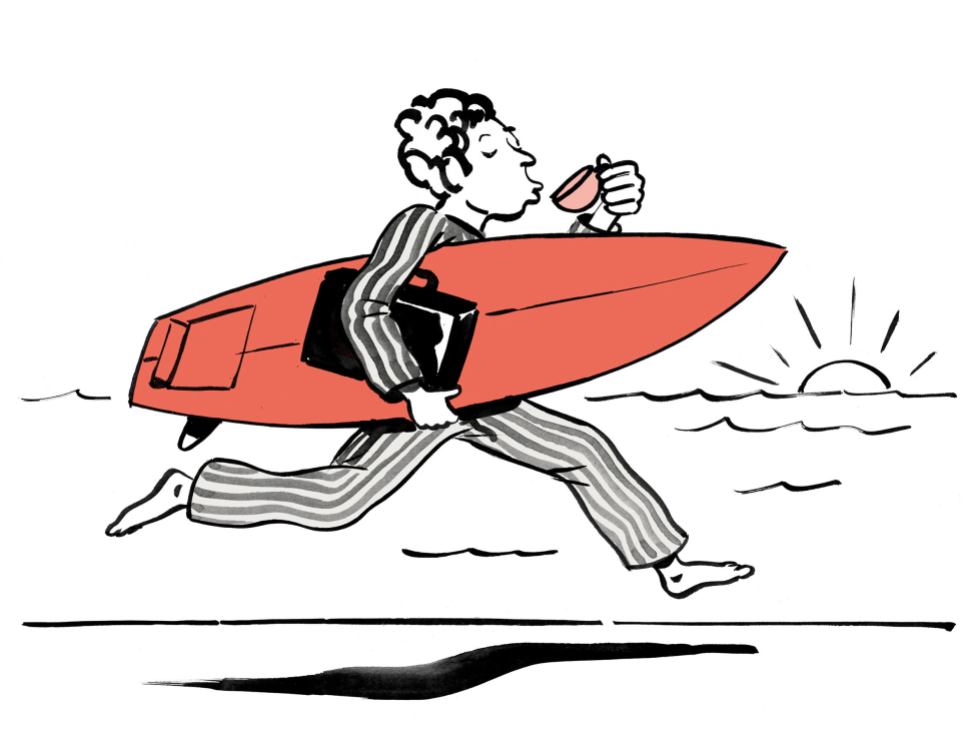
Before we dive in, let’s have a quick temperature check. Who saw the sunrise this morning?
Anna Edwards: Not so much; I was out late last night. That’s the thing – sometimes we want to be out late and have a drink after work, and sometimes we want to get up early and enjoy the morning.
Ivan Power: I’m an early riser. Generally, I’m up at about 05.00 and I’m down at the beach by 05.30, either for a swim, a paddle, a surf or to go to the gym. I’m fortunate enough to live in Bronte, a Sydney suburb that’s home to one of the world’s great urban beaches.
What tipped you off that early-morning activity might be more than just a lifestyle trend, and something worth studying?
I: Since the coronavirus pandemic, I began to notice more people in the mornings while doing my laps. But one day, when I was sitting out in Bronte at 06.30, I noticed that there were no seats available at the seven cafes that line the strip. It dawned on me that this increase in business was an economic thing. I posted a few thoughts about the “morning economy” online, and Anna was one of the first people to reach out and express interest in the topic.
A: I was involved in the first-ever measurement of the night-time economy in the UK, so when I read Ivan’s morning economy piece, I saw a huge opportunity. The early-morning hours provide another time frame for us to utilise outside of the regular nine-to-five workday, which is really beneficial to society. One of the projects that I’m working on now is a global comparison of morning activity, which will be available later this year.
Why should mornings matter to city hall?
A: One of the main reasons that cities around the world are investing in their nightlife offerings is to enhance livability and attract talent and investment. But things are changing. People are drinking less alcohol and we’re seeing a shift in what the younger generation is looking for. It’s all about personal choice and providing opportunities for the sky larks, not just the night owls.
How does it compare to when you started work on the night-time economy?
A: When I first started measuring the night-time economy, nobody had heard of it. I remember talking to friends and they thought that it was all about alcohol, which is not true. It’s about making cities in the evening more vibrant and safer by offering a diverse range of activities for a broader audience of people. We need to apply the same kind of thinking to the morning economy. It’s an untapped part of the day, and from a livability perspective, there are opportunities all around the world for cities to embrace.
What data are you collecting?
A: Trading hours, credit card spending, foot-traffic data – things like that. At first glance, I’m seeing more activity in the warmer months, as you’d expect – but also that Wednesdays and Thursdays seem to be the days when we see the most movement. That could be because people tend to go to the office during the middle of the week.
Does the size of a morning economy depend on culture or climate?
A: Moving from the UK to Australia, I learned that it’s fair enough to invite people to a 07.00 park run. That’s not an anti-social thing to do here. Likewise, there are a lot of Asian countries where the early morning is the only time to be outdoors to avoid the heat. There’s a lot that we can learn based on climate and temperature.
I: Australia can get quite hot, and as a country, we’ve put a lot of thought into our breakfasts – they have to be done really well. In fact, we’ve even exported a little bit of that breakfast culture to the rest of the world.
It’s winter in Australia right now. Does it get lonely in the early hours?
I: It’s not lonely at all, and the number of active people stays fairly consistent. Sure, it’s not as busy in the depths of winter as it is in the height of summer. But there are still plenty of people taking the time to get out in the mornings – to look at the water, walk along the coastal path and watch the sun come up. This is the way that certain cohorts want to socialise, and it’s been quite a development over the past decade.
Is the dawn crowd spending money? Or just stretching?
I: Although I didn’t pay for my gym membership at 05.30, I’m using it at that time and morning people are spending a lot of money on leisure wear and other accessories. Beyond food and drink, there are parts of the morning economy, such as workout classes and clothing, that we are amortising in those early hours.
Is public safety a big challenge?
A: Yes, but not a huge issue. Mornings are a safer option than the evenings because coffee shops and gyms don’t have the same challenges with alcohol-related anti-social behaviour. But during the winter months, we must think about public lighting, transport and having sufficient traffic at certain places to make people feel safer.
Anna, you’ve spent 15 years studying night-time economies and watched cities invest billions in after-dark programming. Now you’re telling them to invest in sunrise too. Are cities spreading themselves too thin, or is this genuinely the future of urban economics?
A: We’ve seen a seismic shift in the way that the night-time economy operates around the world. What was treated as a problem that needed to be suppressed through regulation is now actively supported. There are approximately 80 cities globally with dedicated night-time economy governance, and a broader range of people are socialising at the end of the day. But I should also mention that, right across the world, we’re seeing a shift away from the evening towards an all-day economy. Here in Australia, New South Wales has a 24-hour economy commissioner with a 60-person team.
What might a future-fit, fully awake city look like?
A: Back in the day, shops were open from nine to five, Monday to Friday, because women, who typically stayed home during the week, could go out and do the shopping. But as they entered the workforce, opening hours extended through weekends and evenings to allow people to shop after work. The coronavirus pandemic has shifted things again, which has provided us with an opportunity to think about the way that we use our time and how we can introduce more flexibility. It’s not about replacing the night-time economy. It’s about finding opportunities for businesses in the morning too.
Japan Cuts, North America’s largest festival of contemporary Japanese cinema, kicked off on 10 July at Japan Society in Manhattan. With screenings of 30 films over 11 days, the festival – now in its 18th year – includes premieres, documentaries and restored classics. There will also be a special award for the director and screenwriter Kiyoshi Kurosawa, and a closing reception with traditionally distilled shochu imported for the occasion. Japan Society was founded as a non-profit organisation in 1907 and is today housed in a 1971 building designed by the much-admired architect Junzo Yoshimura. Monocle spoke to Japan Society’s director of film, Peter Tatara.
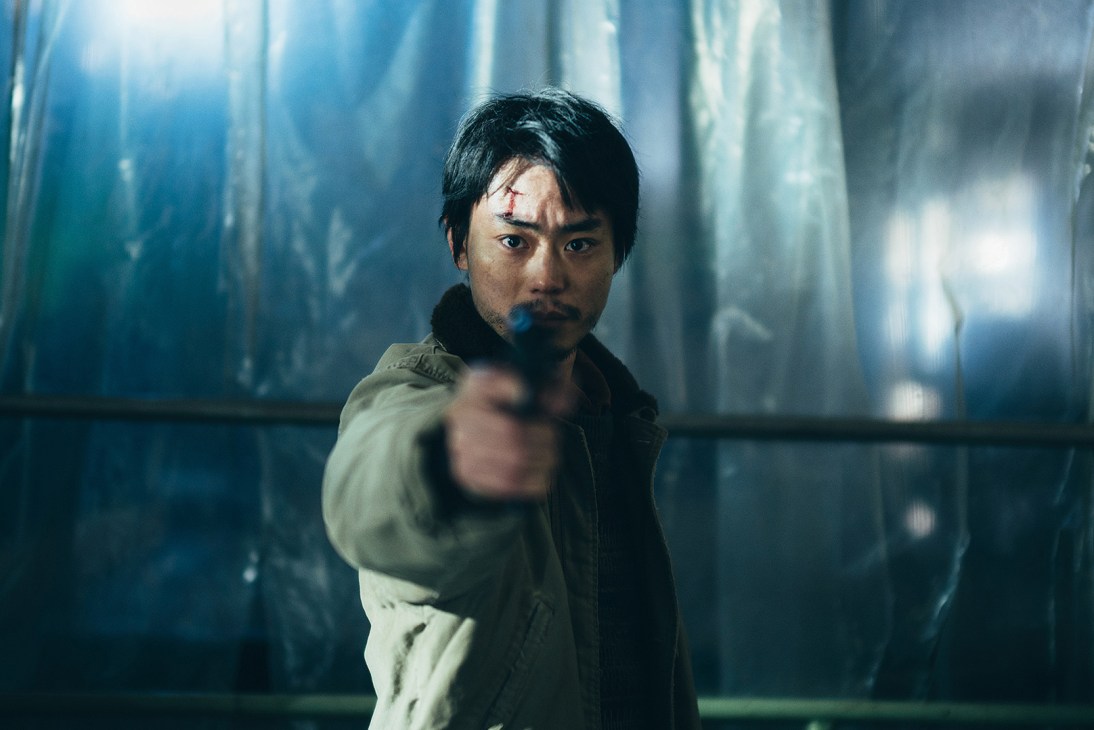
What is the festival’s theme, and how do you make your selection?
Japan Cuts is dedicated to showcasing contemporary Japanese cinema. Each year, the festival offers New York audiences a snapshot of works produced in Japan over the past 12 months – from major blockbusters, indie flicks and documentaries to shorts and experimental works. This year, we’re proud to celebrate the acclaimed director Kiyoshi Kurosawa. He will receive the Cut Above Award, which recognises his lifetime achievements, and we will be hosting the New York premiere of his new release, Cloud, as well as a screening of his recent remake of Serpent’s Path. The selection process takes approximately six months, beginning at the Tokyo International Film Festival, where we spend about 10 days meeting with Japanese film-makers and distributors. To arrive at our final list of 30 films, the team reviews more than 300 works and engages in discussions before deciding on the final selection.
What are some of the highlights?
We are thrilled to welcome Yuumi Kawai, who recently won the best actress award at this year’s Japan Academy Film Prize for her performance in A Girl Named Ann. We’ll be hosting its North American premiere, along with a screening of She Taught Me Serendipity. Further highlights include the first New York screening of A Samurai in Time, which won best film at the Japan Academy Film Prize, and Teki Cometh, which took home the grand prix for best film, as well as awards for best director and best actor at the Tokyo International Film Festival. We’re also excited to spotlight some smaller projects, and our Next Generation section will showcase works from emerging independent directors.
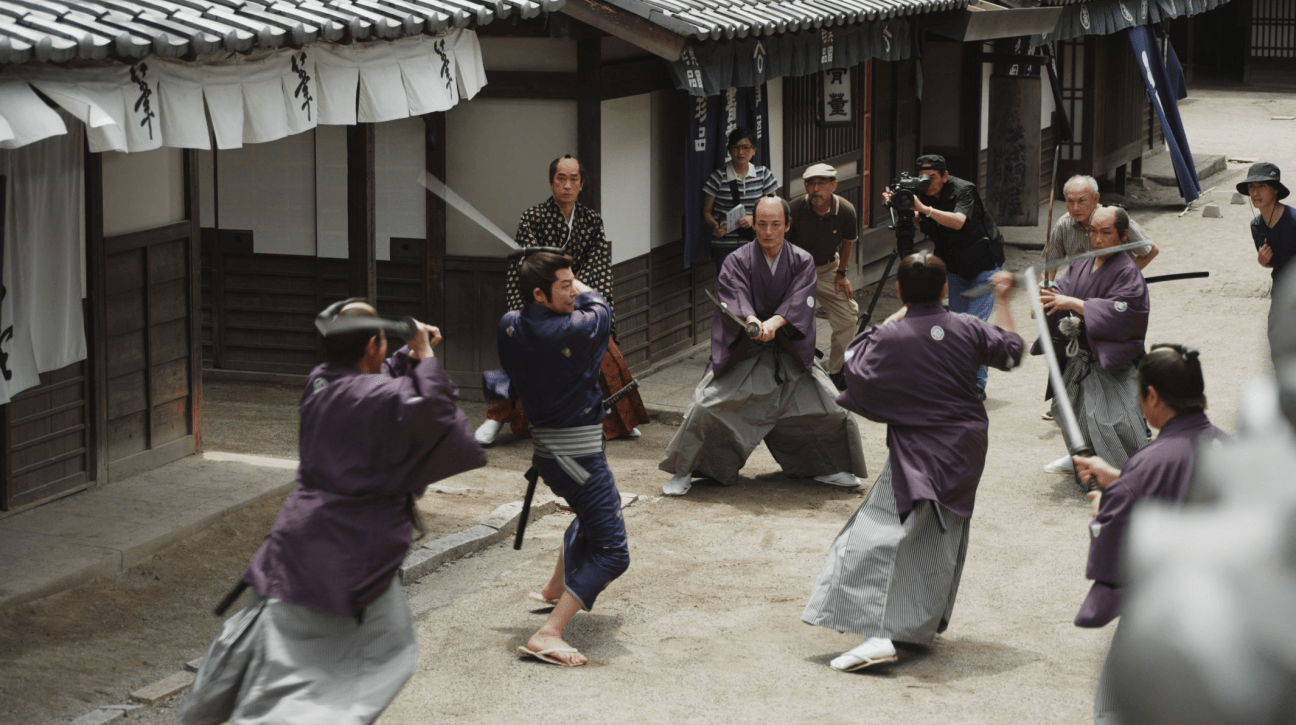
Tell us more about the award to Kiyoshi Kurosawa.
Every year we present a Cut Above Award, which is given to a director or actor in celebration of their contributions to cinema. Previous winners include Yuya Yagira, Joe Odagiri, Kirin Kiki, Koji Yakusho, Shinya Tsukamoto, Sakura Ando and Lily Franky. This year, we’re honoured to present it to Mr Kurosawa, recognising both his works as well as his lifelong commitment to film-making.
And restored classics too?
Every year Japan Cuts features a small selection of classic cinema, focusing on new restorations or anniversaries. With Mr Kurosawa in attendance, we’ll be showing a remastered edition of the original Serpent’s Path from 1998, and a 35mm screening of his License to Live. We’ll also be celebrating the 30th anniversary of Shunji Iwai’s feature debut, Love Letter, with the North American premiere of its 4K restoration.
The closing film sounds interesting – give us a synopsis. Can the audience expect a glass of ‘shochu’?
This is one of my favourite films of the festival. We’re closing this year’s edition with the international premiere of The Spirit of Japan. It’s a beautiful documentary about the Yamatozakura distillery in Kagoshima prefecture – one of the last handmade sweet-potato shochu distilleries in Japan. The film follows fifth-generation master brewer Tekkan Wakamatsu as he carries on 175-year-old traditions passed down by his father, Kazunari Wakamatsu. The documentary gives you a behind-the-scenes look at the shochu-making process, but it offers more than that. It’s a deeply moving portrait of a father and son and an observation of vanishing traditions. We’re honoured to share this film and excited to have director Joseph Overbey and producer Stephen Lyman – and even Tekkan Wakamatsu himself – in attendance for a Q&A. After the screening, the audience can enjoy a reception with Yamatozakura shochu, imported just for this event.
Tell us how you became interested in Japanese cinema. Any favourite films and directors?
I’ve had an interest since I was a child. I grew up in a small town and finding Japanese films on VHS was a window to another world. It made me want to learn more about the culture, the food, the language and eventually inspired me to travel to Japan – cinema is a powerful ambassador to the world. I am drawn to directors such as Kurosawa and Ozu, as well as Fukasaku. Fumihiko Sori’s Ping Pong is also one of my absolute favourites.
Which features would you recommend for novice Japanese film watchers?
If this is your first time attending Japan Cuts, beyond the major titles, I would recommend My Sunshine, a beautiful piece about teenage adolescence; the comedy Kaiju Guy!; the outlandish The Gesuidouz; and So Beautiful, Wonderful and Lovely, featured in this year’s Next Generation section. Together, they give a comprehensive introduction to Japanese cinema.
Japan Cuts runs until 20 July, at Japan Society 333 E 47th Street, New York.
This morning we begin the 48-hour drive south from London to Palma de Mallorca, dog in tow. The other half was working in New York all week and only got home on Friday morning. That still gave him almost 24 hours to get his act together. Last weekend, however, as I was tidying the bedroom, he told me not to touch a small pile of clothes: underwear, socks, a T-shirt. “That’s what I’ll be wearing on our journey,” he said, excited about his holidays. Sweet. Sort of. Though I did have to explain to him that Big Ted and Little Ted would have to stay at home this time. There were tears.
I get to travel a handsome amount with work and always have a bag half-packed. Even so, summer holidays invoke preparation rituals. My dog and I both got haircuts this week – not at the same place, I hasten to add, and my barber certainly didn’t trim my undercarriage. The neighbours have been recruited to water the plants. The transformational promise of travel is on the horizon – we are going somewhere. And I am not the only one from Monocle on the move.
In the coming days, several members of the London team will be heading to Bangkok, where they’ll meet up with James Chambers, our Asia editor based there, to start working on a new Monocle Handbook on Thailand. (The series’ previous editions have covered Portugal, Spain and France; the one on Switzerland is currently at the printers.) I love these books because they encapsulate our thoughts on the idea of travel: they are concise; they spotlight hotels both high and, well, a little less high; they take you off the beaten track and introduce you to people who know the country. And they’re the perfect companions whether you’re planning to stay for days or weeks – or are even considering putting down roots. In short, you need a set on your bookshelves.
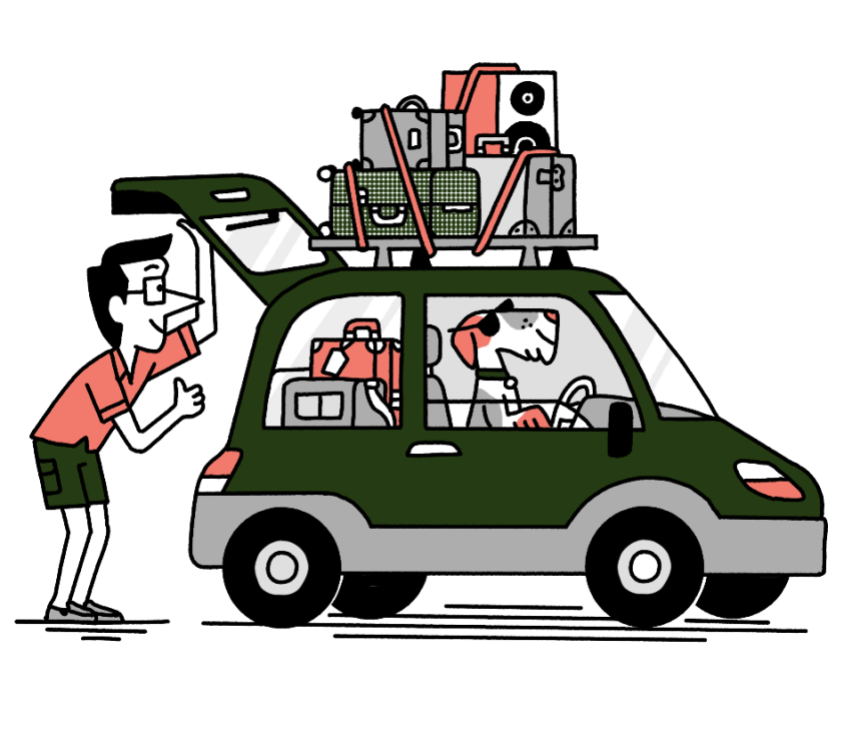
And talking of perfect companions, how about letting our design editor, Nic Monisse, and editor, Josh Fehnert, keep you amused on your travels? The editorial duo – sort of the Danny DeVito and Arnold Schwarzenegger of Midori House (in that Nic’s also a stand-up comedian and Josh is a Matterhorn of a man) – commissioned, cajoled and concocted a perfect line-up of essays to celebrate the on-going Venice Biennale. Called The Monocle Companion: 50 Ideas on Architecture, Design & Building Better, it’s a great beach read or flight-time filler. It’s clever and amusing, like its editors. It’s available here.
If you did the right thing and clicked that link, you will have noticed that subscribers to Monocle get a discount on their purchases. There’s another thing that subscribers get: free access to a fast-evolving catalogue of online, bang-up-to-date City Guides. Mexico City was just added to the line-up at monocle.com and Madrid will be next. These guides take you beyond the usual spots to discover cool neighbourhoods, fun chefs, the best inns and unmissable retail outposts. Plus, you can download a handy map to your phone. I know, crazy stuff.
And that discount even applies to tickets for our annual Quality of Life Conference, which will be taking place in Barcelona from 4 to 6 September. Perhaps we can entice you to put the city on your travel agenda and join us? Since we started the series more than a decade ago, the conference has become the key moment for Monocle readers to come together, mix and mingle, like the ingredients in a tasty paella. You can find the full details here. If you book, we’ll also be sharing details of our Patrons programme that comes with another bonus – a chance to have a holiday with team Monocle. Intrigued? You know what you need to do.
Anyway, I’d better get off this laptop and return to my lap dog. It seems that I am in charge of all music and radio-station selection (he’ll do anything to stop me driving). But wait, is that Big Ted I see poking out of his bag?
With summer in full swing in Asia, we asked five business leaders from across the region to open their closets and walk us through the choices that carry them from morning meetings to evening engagements. Here they share their go-to brands, daily uniforms and outfits that they reach for when the stakes – and temperatures – are high. From Tokyo and Hong Kong to Bangkok, Manila and Jakarta, dressing the part is about more than just appearances: the right fit, pleat or hem can convey subtle messages about the wearer’s style, spirit and respect for the occasion.

1.
Carlos Granon, founder of accessory brand Topologie
Home city: Bangkok, Thailand
Describe your everyday outfit.
My vibe is “Tokyo utility meets mountain grit”. I usually wear Graphpaper’s oversized shirts, FreshService’s modular cargo pants and a Universal Works baker jacket for that high-altitude retro edge. I always reach for Unfeigned’s breathable travel jacket, white Norda trainers and I, of course, accessorise with a Topologie climbing-rope strap.
Best shops?
In Japan, I hunt for gems in Harajuku’s boutiques and Kyoto’s Sanjo concept shops – my secret weapon for rare finds. Graphpaper’s flagship locations can never be missed, wherever they are. In London, I go to Universal Works’ Soho shop and End Clothing. I also explore Brick Lane near Spitalfields Market for secondhand wares.
Your favourite brands and new ones to watch?
I like And Wander’s techy-trail vibe and FreshService’s utilitarian edge. Universal Works and Unfeigned keep their looks timeless. Service Works has perfected relaxed trousers and New Amsterdam’s oversized T-shirts are my latest go-to.
And when things heat up?
Ditch heavy shoes for Keen cord trainers. Topologie’s cross-body bags keep your gear sweat-free, while New Amsterdam’s sleek caps offer sun protection with a side of style.
2.
Paloma Urquijo Zobel de Ayala, creative director of property developer Ayala Land Hospitality
Home city: Metro Manila, Philippines
Do you have a daily uniform?
My everyday look is a mix of structured and expressive pieces that reflect my personality. Tailored suit trousers paired with a patterned or architectural blouse, often from Filipino designers such as Carl Jan Cruz. Wearing homegrown pieces always sparks conversation in meetings with business partners; it’s a subtle way to champion local creativity and get a fun discussion going. My go-to item is a sturdy tote that’s big enough to carry my whole life.
Where do you shop?
I believe in investing in fewer, better pieces that can be worn in multiple ways. I usually shop when I travel. It’s how I discover new designers and tailors, and build a wardrobe with stories behind it.
Some brands that you like?
Carl Jan Cruz, Nili Lotan and Loulou de Saison. I wear Etro suits for all of my important meetings and events. When I need to get my hands dirty during site inspections, I opt for Wrangler or Ariat boots.
Check-in or carry-on only?
Always a carry-on. I pack a navy-blue suit that works across occasions, which I can dress up with a fun blouse or dress down with a T-shirt and a cap (this is particularly useful when I haven’t done my hair on the return journey).
3.
Betty Ng, founder of architecture-and-design firm Collective
Home city: Hong Kong, China
Describe your everyday workwear.
I appreciate clothes that emphasise form, structure and material. I’m a fan of accessories – mainly earrings – and in the winter, a scarf. I love the label Sunnei and jewellery from Monies. My friend David Andersson makes the most beautiful chunky bracelets and Lama Hourani’s collection inspired by sculptor Eduardo Chillida is stunning. I tend to go for statement earrings – they add a fun accent to a wardrobe full of black and solid colours.
Where do you shop?
I’m 174cm tall and in Hong Kong it can be hard to find clothing and shoes that fit me
well. I shop when I travel, particularly in Europe and, surprisingly, in Japan.
What brands do you like? Any recent discoveries?
I’ve started buying from Sacai and Prada’s nylon series. I enjoy their play on materiality and form, and I like pieces with a clear silhouette. I’ve been wearing Comme des Garçons for years and still love it. The brand also introduced me to Noir Kei Ninomiya. Uniqlo is a go-to for simple items. Dries Van Noten has also always been a hero of mine; I tend to look for special pieces that highlight his incredible textiles.
Any tips for staying (and looking) cool during a hot and wet summer?
I am a big fan of skirts and dresses – they’re a lifesaver during Hong Kong’s hot, humid summers.
4.
Hiroyuki Isobe, managing director of interior-design firm Wonderwall
Home city: Tokyo, Japan
Describe your daily workwear.
A navy, grey, black, beige or olive colour palette, with either black or white leather shoes and striped socks. In formal settings, I’ll wear a three-piece suit, either in grey or navy, with a black tie. On more casual days, a work jacket with chinos or denim. I don’t wear accessories during business hours besides a watch and my wedding ring.
What brands do you like?
Engineered garments, DC White, Markaware, Uniqlo, Church’s, JM Weston, Chausser. Unionwear by Traditional Weatherwear is a new addition – I like the wide chinos.
Where do you like to shop?
I usually buy directly from the brand’s shop, with the exception being Freeport – a boutique in Ueno, Tokyo. It sells a full range of pieces by DC White and the owner is very enthusiastic about the labels that his shop carries.
Who makes the best white T-shirt?
It’s between Uniqlo’s cotton Airism and 45RPM’s shirts.
5.
Arini Saraswati Subianto, president director of holding company Persada Capital Investama
Home city: Jakarta, Indonesia
Describe your overall look.
Clean, monochromatic and mostly solid textiles. Non-fussy and non-restrictive. My go-to colours are white (I collect white tops), off-white, cream, navy, black and camel. I’m more of a trouser person but lately I’ve acquired quite a skirt collection, which includes some custom-made, pleated, midi-length batik pieces. I am petite so I avoid dresses – most need alterations due to my height.
Favourite brands?
United Arrows and Tomorrowland for jackets and trousers; Vince for tops; James Perse for T-shirts; and Loro Piana for sweaters. Theory covers a lot too. For dressier pieces I go for Dior and Michael Kors for A-line dresses. I also discovered a few Carolina Herrera pieces that fit me perfectly without alterations.
Any jewellery or other accessories?
I wear layered necklaces on a daily basis and I’m not afraid to mix silver and gold. I’ve recently been playing around with different gold-plated earrings that I’ve picked up from brands including J Crew, United Arrows and Alexis Bittar. There are times when I might add a vintage brooch but I usually just grab whatever is on the tray in my bathroom.
How do you dress for the heat?
It’s summer all year round in Jakarta but our offices are air-conditioned, so I usually layer my clothes and combine a sleeveless top with a structured jacket. I prefer cotton or silk button-down shirts when it gets particularly hot, styled with wide trousers and flats. For me, T-shirts are for life outside of work and I don’t wear open-toe shoes to work either.
In June the employees of Singapore’s 1880 Club had a rude awakening: the eight-year-old private members’ institution had closed down without warning. Marc Nicholson, its founder, chalked it up to a drop in attendance and lower spending by members. Its Hong Kong branch had closed two weeks earlier after just seven months in operation; its Bali outpost, meanwhile, never saw the light of day, with construction coming to a halt late last year. And 1880 isn’t alone. Singapore’s country clubs, which sprouted up in the 1980s and 1990s, have been struggling to keep up too. A few days ago, four of them hit the rough when the government chose not to renew their golf-course leases. There’s a common thread: stop by places like these today and you’ll be hard pressed to find a young person. Members have grown old and these once sought-after “third spaces” are now on a slow march into obscurity.
But not all of them. Two of Singapore’s leading private members’ clubs are still chasing growth. The Mandala Club, renowned for a string of Michelin-starred chef pop-ups, is expanding its footprint by 50 per cent and has a new club-hotel concept in Bali under way. And 67 Pall Mall, founded in London, is even more aggressive: not only is it about to open a Shanghai branch but it has also announced ambitious plans to launch further locations in the next two years.
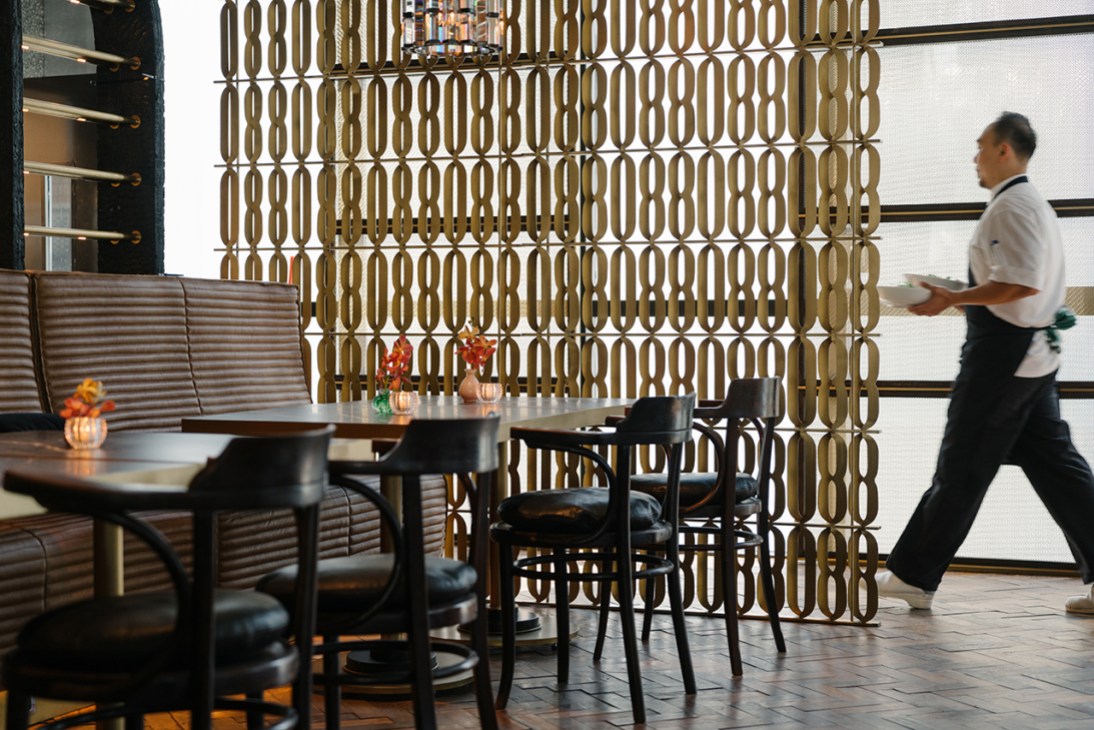
So what’s behind the contrasting fates? In an age when almost everything is mediated by screens, isn’t actual face time sought after more than before? These two thriving Singapore-based clubs show that the trick to getting a community right is to find a niche, then make what you offer feel part of your environment.
That’s what 67 Pall Mall Singapore, a club centred around fine wine, has captured in a bottle. Its founder, Grant Ashton, could have replicated the successful London flagship but he chose instead to ensure that the Singapore outpost catered to local audiences. “So much of what we do is personal – 67 Pall Mall here is not a cookie-cutter club,” he says. “It’s aimed at Singaporeans.” To satisfy residents’ thirst for cerebral pursuits, it holds masterclasses and events that enable members to learn while sipping wine. “A big piece of what we do is making sure that people are getting more than just entertainment,” he adds.
While many establishments have sought the patronage of business leaders who want privacy and discretion, The Mandala Club has taken a different route. “People sign up because they share the same values as us; it’s not exclusive for exclusivity’s sake,” says Ben Jones, the CEO and co-founder of The Mandala Group. Jones keeps a lookout for Singapore’s young entrepreneurs. “The start-up environment is huge here and we’ve got a thriving under-30s member base,” he says. The club runs a mentorship series in which unicorn start-up founders or executives from multinational companies share their advice. Jones came up with these programmes after spending time walking the grounds, making introductions and matchmaking up-and-comers with experienced heads. “I’m here all day, every day,” he says. “We are very hands-on and recognise that this isn’t necessarily a product that you can scale too much.”
Two weeks after 1880’s closure, its former employees announced that they would open a new club in the same venue with the landlord’s backing. It goes to show that there’s an appetite for clubs done well. Offering familiarity and friendship in a world that can feel in a constant state of flux is no small feat. But entertainment has a short shelf life – success lies in diversity and well-considered offerings that have a meaningful sense of place. If you can master that, where can we sign up?
Koh is a regular Monocle contributor. In need of a drink in Singapore? Check out Monocle’s City Guide here. For more opinion, analysis and insight, subscribe to Monocle today.
When was the last time you took a beat and just sat back? When did you last steal a few moments from the crush and thrum of city life to watch things pass? I’m told urban living is busy but taking a load off is my forte. I’m also quite proud of myself. I have weathered difficult times, I put my back into my work and I’m there when people need me. I’m told that I can be very supportive. Yes, I’ll admit that I can be stuck in my ways – a little wooden at times – but compared to those around me, I have a rather sunny outlook. Oh, I should perhaps clarify at this point that I am a park bench.
I’m not sure how long I’ve been in my current position but the trees around me have budded, blushed and shed their leaves countless times since I first set carved foot in this city park. The chirp of the birds and the hum of the high-street traffic is a soundtrack to which lives have unfolded on and around my slatted lap. I’ve heard the reassuring morning natter of neighbours who rest with me during morning saunters, and provided sanctuary for joggers, toddlers and oldsters. Most are lovely but, in my line of work, you come rather close to a few arseholes now and again.
I’ve seen crying babies, sore knees, spilled coffees, mudpies, quiet cries – two marriage proposals (one consummation) and a catalogue of incidents that you wouldn’t believe if I told you. Not everything that happens in cities is pretty. In some small way, though, I like to think I’ve helped. My haunches, painted iron sides and sturdy seat board are a little mucky but I can still offer succour to plumbers and poets alike. I’m a democrat at heart and wouldn’t discriminate against those I spend time with. I could, however, live without those pesky pigeons using me for target practice, I’m a bench; spare me the stool.
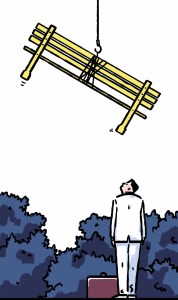
Now I’m not what you would call well-travelled but I have a hunch that my kind has been around almost as long as yours has. Human history, I’m told, is all about movement but since merchants first traded, people massed and cities convened, your kind has relied (at times heavily) on mine for relief.
As a public bench, I’m more civic-minded and less doctrinaire than the church pews I’ve heard about, and less courtly than my cousins in parliaments or palaces. I’m rougher around the edges than the newer, more ergonomic breeds I’ve glimpsed in magazines (people leave the darnedest things on benches). But it’s a proud history: my stone-and-marble forebears were in ancient Athens at the birth of democracy.
Much more recently, the arrival of my spindly-legged relatives marked a democratic shift in urbanism as public benches popped up around the world, lining the boulevards of Haussmann’s Paris, Central Park in New York and dotting the banks of the Danube in Budapest.
We might not always say it but public seating is a mark of civility and shared humanity. A benchmark, if you will, of co-operation.
Which brings me to my biggest fear. A neighbour of mine from down the way has told me about a worrying new trend. In my native London, there’s a design known as the Camden Bench. The thought shivers my timbers. Launched in 2012, the unsightly concrete carbuncles are the apotheosis of what you humans have dubbed “hostile architecture”, bits of the built environment designed to discourage lingering too long. It deters littering, drug dealing and rough sleeping, and can serve as a roadblock. But a bench that rebuffs sitters? Have you ever heard such a thing? It might be my Victorian values shining through but this just doesn’t sit right with me.
Luckily, you lot aren’t taking this sitting down either and a wealth of competitions are helping to create and install welcoming new designs. We park benches – donated, commissioned, old, new, flaking and freshly painted – remain an unsung player of public life. What would the films Forrest Gump or La La Land be without us? And shouldn’t there be a supporting role award out there for a Dame Judi Bench? We’re there holding up the plot of spy novels and in paintings by Manet and the photography of Brassaï. Success is about bums on seats. We benches are a rare thing: a place to be still amid the bustle and by ourselves but with others. I sometimes catch myself daydreaming about what life might be like beyond the rat race, rubbish and out of earshot of the car horns. Unlike the benches across the way, my life isn’t always a picnic. What if I found somewhere to perch on a quiet country lane or leafy village green? But who am I kidding? The countryside just isn’t for folks like you and me; I’m old but I’m not useless yet. Technology might have changed but I still matter. And if you want me, I’ll be here to lean on.
About the writer
For all its plus-points, a park bench might struggle to tell its own story. This one, which has chosen to remain anonymous, spoke (between sittings) to Monocle’s editor, Josh Fehnert. This essay, and plenty more city-focused ideas are available in The Monocle Companion: Fifty Ideas For Building Better Cities. Buy your copy today.
Pope Leo XIV has quit the heat of the Vatican and taken up residence in Castel Gandolfo, a papal property that sits atop a hill southeast of the city, with a calming view of Lake Albano. He’ll be there until 20 July and has also booked himself in for a long weekend in August.

Leo’s departure from the sultry Holy See has made the news because his predecessor, Pope Francis, was not a Gandolfo man and declined to spend his summers there (indeed, he displayed little interest in most of the potential perks of the job, eschewing much of the ceremonial regalia and even moving out of the papal apartments in Vatican City). Unsurprisingly, the locals are delighted that Leo has embraced this summer pope-on-the-move tradition that dates back to 1626, even if there is still no official Leo trinketry for them to sell in the souvenir shops.
Leo, aka Sporty Pope, is expected to fit in some tennis and find a spot of downtime. But he’s unlikely to have an out-of-office (OOO) message set on his laptop – the American Pope reportedly has a habit of staying up to 03.00 sending messages on Whatsapp. Plus, he has his first encyclical to bash out.
And in this, the Pope reveals himself to be a man of our times. For while he might be more associated with Holy Weeks, he is, like many of us, also a paid-up practitioner of “holi-work”, that limbo in which you are definitely not in the office but have also not been able to – or, in some sad cases, even wanted to – fully sever the umbilical cord to the day job (despite the fact that you are suddenly reading your work correspondence while dressed in pink swim shorts and little else – a look that even our most fashion-forward staff couldn’t get away with at Midori House).
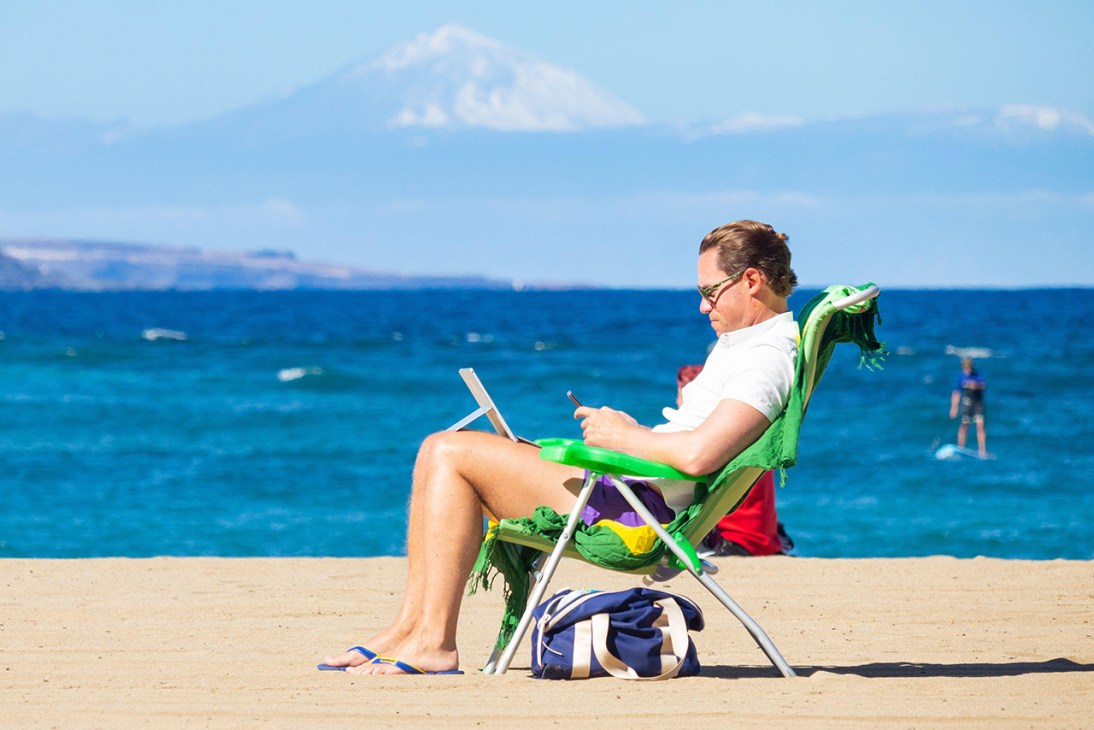
In recent years, many countries have passed so-called “right-to-disconnect” laws to ensure that employees – even popes, I imagine – can ignore work-related emails while on their holidays. But for many folks, trying to totally disconnect, to put out of their minds what might be lurking in their ever-expanding inbox, is more anxiety-inducing than giving it a daily scrub-down.
For many years, Monocle staff didn’t set up OOO messages. In the early days, when we were a fledgling brand with a tiny team, we worried about a commercial contact going elsewhere, a reporter with a great story not waiting around for our response. Now fully embraced, OOO notes have had no detrimental effects but their use is still a little haphazard because of people like me.
This weekend I leave the city for a couple of weeks. While there’s no castle involved or encyclical to write, I know that the line between my work and private lives blurred long ago and that I will also definitely want to file my column, check my mail, be a little on. In part, it’s because I remember a time before all of this, when I would return from long travels wondering whether my company was still afloat and my job still there.
Perhaps that’s the important bit. Vacations should be when you decide what makes the perfect cocktail of your time – is it a zero-per-cent-work concoction or something a little trickier to mix just right, a “holi-work special”? And here’s a line that a Protestant rarely types: I’m with the Pope on this (though I imagine that I might be having more real cocktails than him). Some writing, some downtime and some exercise will be just the ticket. But I can’t go along with Whatsapping in the middle of the night. Isn’t there a nun who can take away his phone at bedtime?
In a world that feels more unpredictable by the day, who craves a crystal ball more than insurers? From climate disasters to political shocks, risk is everywhere – and for insurance companies, reading the future isn’t a luxury – it’s the business model.
To understand how they’re making sense of it all, Monocle sat down with Gilles Moëc, chief economist at AXA Group. The French insurance giant operates in some 50 countries and Moëc leads the in-house team tasked with spotting trouble before it hits.
He splits his time between Paris and London, and is disarmingly calm for a man who describes his job as “worrying constantly”. We asked him about climate policy, the return of Trump, AI and whether Europe’s big defence spending spree might actually be a good thing.
What does your day-to-day look like as chief economist?
Producing scenarios and worrying constantly is a definition of what I do. Insurers tend to stress about “what-ifs”. For instance, we pay a lot of attention to the global fight against climate change, which is one of the most critical drivers shaping the world economy today.
It’s now half a year into president Donald Trump’s second term. How worried are you about the backlash against renewable energy in the US?
The understanding back in October and November of last year was that although some of the Biden administration’s subsidies for solar and wind power would be eliminated, most of the decarbonisation efforts would continue because many of the projects were going to be implemented in Republican states. Now that we have the final version of the ‘big, beautiful bill’, we know that most projects are going to be dead in the water. During the first mandate, there were no big changes in the speed of decarbonisation. This time, it looks different.
Do you see environmental concerns and decarbonisation falling behind in the pecking order in Europe as well?
I’m quite optimistic about that, because economic, environmental and geopolitical interests are aligned across Europe. The US is now the biggest producer of oil and gas in the world. Every year, Europe spends between two to three per cent of its hard-earned GDP on importing fossil fuel from the rest of the world, which puts us in a fragile position, as we saw when the war broke out in Ukraine. So for us, decarbonisation isn’t just our contribution to the fight against climate change. It’s also a way to make progress towards geopolitical sovereignty, as it is a way to save money in the future.
What are France’s economic strong suits?
Compared to many big European countries, France still has a demographic vitality that you can’t find elsewhere. The country produces a disproportionate number of global brands and companies. France is also one of the very few countries close to achieving energy sovereignty, and we can offer companies operating in the nation electricity costs that are more attractive than a lot of other locations.
What are the French economy’s weaknesses?
First, education. It used to be one of our key assets but the system has deteriorated, and it needs to be addressed because it concerns our long-term growth. The second is our ageing population. Even if we are in a better demographic position than many other European countries, we also have a fairly generous welfare system that doesn’t cope well with ageing. Taken together, these two issues are going to pose significant fiscal challenges that need to be dealt with.
How does AI fit into this picture?
France is in a fairly good position. There’s an established start-up culture and we already have an AI producer. The key is not only having companies that develop AI solutions but also ensuring their adoption. Digitalisation in general happened faster in France than in Germany, so I’m hopeful that, even if we are not among the top producers or innovators in the technique itself, we can at least adopt it quickly. You also need to have a government that allows exploration before regulating. In Europe – it’s not only a French problem – we very often have the reflex of regulating before we’ve seen implementation. This is where we need to take a hard look at ourselves.
Do you see the growing consensus that Europe needs to invest massively in its defence industry as a positive economic development?
Some extra spending will have a positive multiplying effect on our economy. Military equipment manufacturers employ high-skilled blue-collar workers at a time when there are very few sectors that do. And there will most likely be some developments in productivity.
The Apollo Program in the US, for example, had an effect not just on productivity through new research but it also forced American companies to follow some innovative management and quality-control techniques. Additional investment is not going to change the face of the European economy but it can benefit it.
Here in Marseille, we’re usually grateful for the cooling breeze that blows in from across the Mediterranean. However, this week the wind fanned a wildfire burning on the city’s hinterland. The blaze was soon at the gates of France’s second city and led to emergency evacuations, damage to scores of homes, the airport’s closure and the disruption of rail connections to Paris. On Tuesday lunchtime in my quartier in central Marseille, the sun suddenly turned an incensed orange as billowing clouds of smoke rose from the city’s northern flank. My throat grew scratchy and my eyes began watering. Local authorities later advised residents to stay indoors and keep all windows closed.
Many of us who live in the south of France have been factoring the risk of wildfires into our summer plans for some time now. Rising temperatures and more frequent heatwaves are key factors but the French authorities note that human activity is by far the most common trigger of such infernos. Government figures suggest that 90 per cent of blazes in the country are caused by negligence. The interior minister, Bruno Retailleau, repeated this sobering statistic when he arrived in Marseille this week, warning the public of a “high-risk” summer.
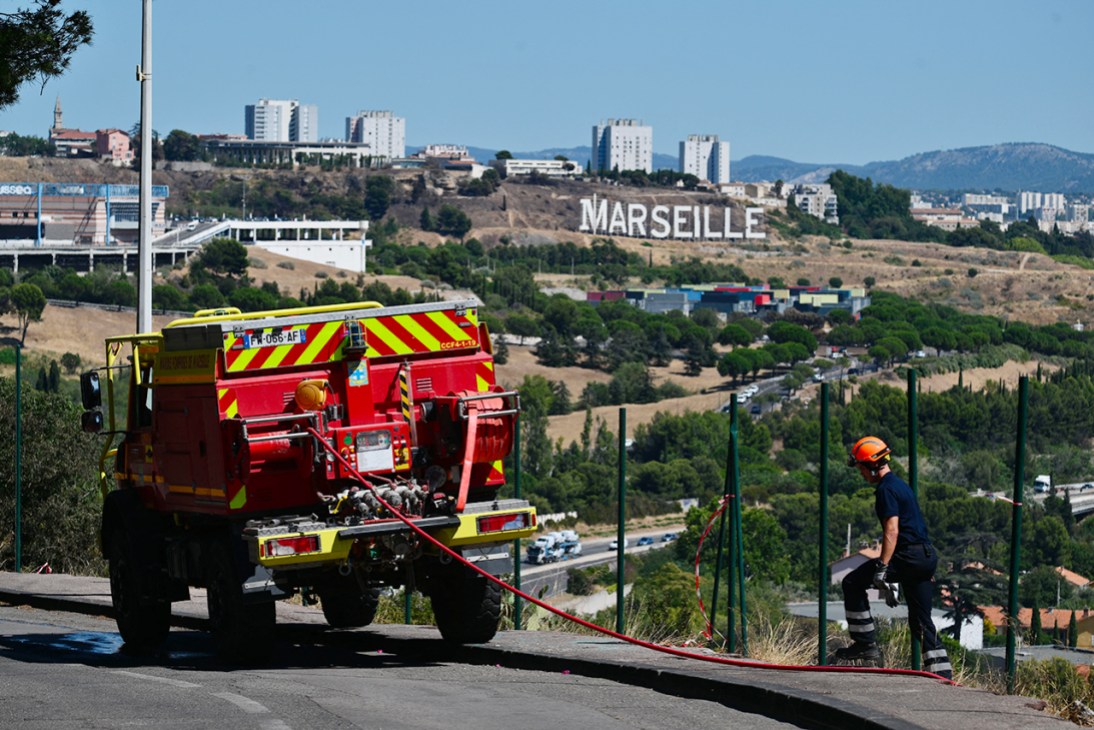
Two years ago, while reporting for Monocle, I gained some insight into how the increasing frequency – and ferocity – of wildfires is spurring France to action. In Velaux, a village about 35km from Marseille, thousands of firefighters have been trained at a special facility for learning how to tackle forest fires. The centre features a unique simulation site dotted with tree-like metal structures that erupt in gas-powered flames.
“In the Mediterranean region, we have been confronted by such fires for a long time but the season is getting earlier and earlier every year,” Jean-Luc Beccari, the director of the Departmental Fire and Rescue Service of Bouches-du-Rhône, told Monocle. But the longer-term trajectory in France and elsewhere in Europe looks ominous: a UN report projects that wildfires on the continent will increase by 30 per cent by 2050.
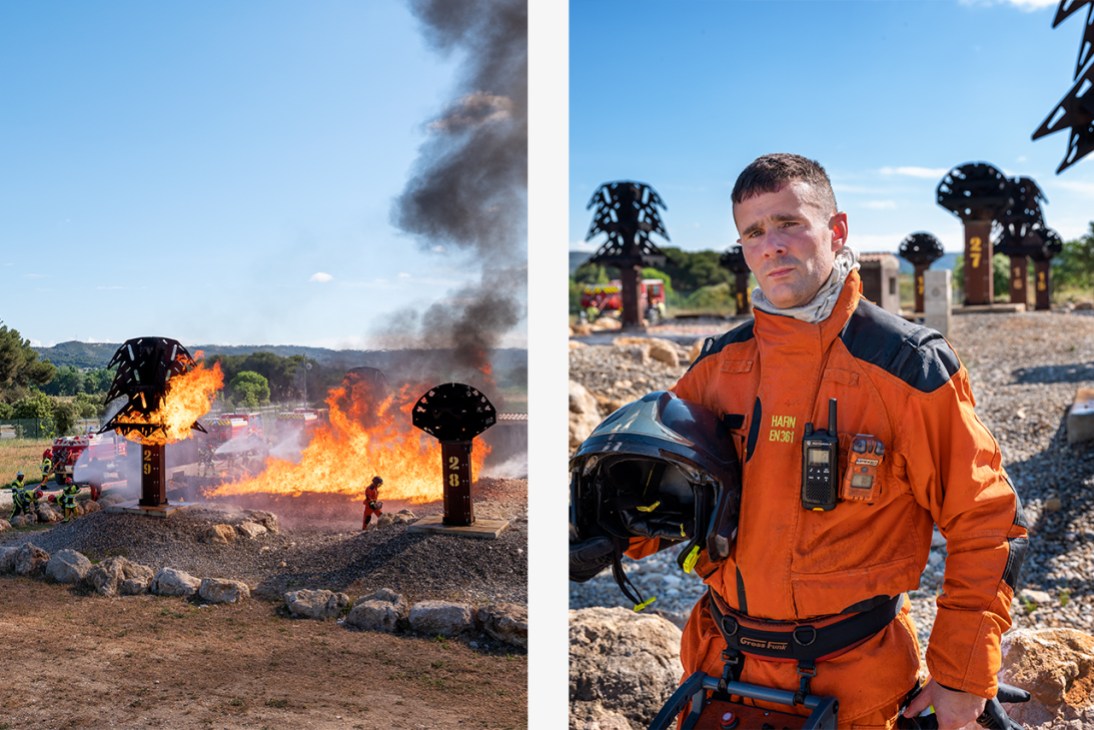
While France is trying to persuade more people to sign up as volunteer firefighters – some estimates predict that a further 50,000 will be required by 2027 – it’s also trying to tackle the issue with legislation. In 2023, French parliamentarians voted to outlaw smoking in all forests and woodlands during periods of elevated risk. That ban built on an existing law forbidding the lighting of fires within 200 metres of wooded areas.
Staff members in Velaux told me that their wildfire simulation site was the only one of its kind in Europe. They’re keen to share lessons with other nations across the continent experiencing an uptick in wildfires. In countries from Spain to Greece, towns and governments can learn from France’s focus on raising public awareness, investing in specialised training centres and encouraging recruitment and volunteering. As Beccari put it, “This is a collective challenge that affects us all.”
Fitzgerald is Monocle’s North Africa Correspondent. For more opinion, analysis and insight, subscribe to Monocle today.



